Reading Out Loud
Focused Elements:
You can have these explanations read out loud by clicking on 'Speak Explanation' (access key 'a')
These controls are to provide alternative means of accessing the information on this page. Two main facilities are provided: adjusting the text size and listening to the text on the page.
1) Adjusting Text Size:
You can increase the text size by clicking on 'Larger' (access key '+'), and reduce it by clicking on 'Smaller' (access key '-'). You can reset the size back to its original value by clicking on 'Reset' (access key 'j')
2) Listening to the Text
You can adjust the pitch of the spoken word, the rate or speed of delivery and the volume. You can also choose the voice to use by clicking on the drop-down list. The default voice is whatever is the standard for the computer and browser you are using.
To set your default, please refer to the description in the Accessibility Statement.
There are normally three sections of text on the page that you can listen to: the headings, the main text and a selection. Click on 'Speak Headings to speak the page headings (access key 'l'). Click on 'Speak Main Text' (access key 'q') to listen to the main text.
You can also select an area of text in the page using standard select methods and click on 'Speak Selection' (access key 'w') to read the selection aloud.
You can enable the reading out loud of the element that currently has focus by clicking on 'Start Focus Speaking' (access key 'f') and you can stop this by clicking on 'Stop Focus Speaking' (access key 'd').
You can pause the audio by clicking on 'Pause' (access key 'r') and resume by clicking on 'Resume' (access key 't').
To cancel or stop the audio click on 'Cancel' (access key 'y'). To restart the current audio from the beginning, click on 'Restart' (access key 'k').
To hide the accessibility controls click on 'Hide Panel' (access key 'h')
To hide this explanation click on 'Hide Explanation' (access key 'x')
Widecombe-in-the-Moor
Local History Topics of Interest

We have started to record items large or small related to any topic of historical, local or recent interest, mainly about the history of the parish.
Some of those items are listed here.
If you have any comments or further information about any of these topics then please do Send us an email.
The topics covered are given below with links to the text.
- Widecombe Thunderstorm
- A Strange Substance
- Widecombe in the 1600s
- The Church Tower
- Bowling Alley
- Loganstones
- Widecombe Original Village Sign (1)
- North Hall Dig 2017
- Lizwell Pack-horse Bridge
- Great Elizabeth Mine
- New Stile at Northway Bridge
- Charabancs
- The Beatles Magical Mystery Tour
- Boundary Stones
- Wind Tor
- Brook Lane
- More on the Original Village Sign
- North Hall Café
The first set of continuation topics can be found on the Miscellaneous Topics One page.
The second set of continuation topics can be found on the Miscellaneous Topics Two page.
The Thunderstorm
One of Widecombe's most famous incidents occurred on October 21st 1638 when a violent thunderstorm hit the church during Sunday prayers and caused substantial damage and significant injury and loss of life.
There is a contemporary account that provides most of what we know about this event. It appeared a few weeks after the incident in "The Harleian Miscellany" and is believed to have been written by George Lyde, the vicar of the parish, who was conducting the service at the time of the storm.
Robert Dymond, local Widecombe Antiquarian, reproduces the Harleian account in his 'Things New and Old in the Parish of Widecombe-in-the-Moor" (1876). It provides a graphic account of the injuries sustained.
Reference is also made to the storm in John Prince's "Worthies of Devon" (first published 1701 and reprinted in English in 1810), which includes George Lyde as one of the worthies, principally it is believed (by Dymond) because of his bearing witness to the storm.
The severity of the thunderstorm is clear and because of its early date it is not well understood. There are suggestions that an earthquake may have been involved as well. In 'The Seismicity of Cornwall and Devon, a paper by R.M. Musson, read at the January 2000 annual conference of the Ussher Society, there is a discussion of earthquakes in this area which mentions that an earthquake brought down a pinnacle of Widecombe Church in February 1752. More food for thought.
A Strange Substance
On page 102 of Dymond's book, in his reproduction of the Harleian's words there is a description of David Barry (the 'man' of the Lord of the Manor of Widecombe) going up the tower for the first time after the storm and encountering a strange substance:
"Then coming down lower, in one place in the stairs....there was a round patch as broad as a bushel, which looked thick, slimy, and black....to which he put his hand, and felt it soft, and bringing some thereof from the wall...it was like slimy powder, tempered with water; he smelling thereto, it was so odious even beyond expression and in a far higher degree of loathsomeness than the scent which was in the church...". The sexton accompanied David but soon returned to the ground 'in a great fright'.
What could this substance possibly be?
We now think this was ball lightning. More on this soon.
My thanks are due to Brian Wilkinson of Lewtrenchard who first stimulated me to look into this by referring to the account of the storm in his ancestor the Reverend Richard Polwhele's book "History of Devon" (first published 1797), which quotes Prince as his source. Also to Peter Carrett for pointing out the Musson paper on Seismicity.
Widecombe in the 1600s
Dymond also reproduces a poem believed again to be by Lyde and produced soon after the events. On page 104 the poem starts and there are several points of interest:
- Mention of 'Niprel' - another name for the East Webburn
- The River Dart that 'abounds with salmon-peal and trout'
- How well 'that place is stored with Deers that brouze'
Oh that such abundant wildlife could be present on the Moor today. Unfortunately hunted close to extinction, and perhaps affected by pesticides etc. Who knows?
...and also reference even in 1638 of the legend that the tinners paid for Widecombe Church Tower to be built:
'Much hidden treasure lies in mines of tin
Which have erected such a tower in height
The Church Tower
Further to the mention of the tower above, we were discussing whether the present tower was erected before or after the storm. It would appear that the tower that was in existence in 1638 and mentioned in the poem is the one that is still in use today. We know this partly because Dymond says (page 89) "The effects of the storm may still be traced in a vertical rent on the north side of the tower". This is no longer the case as, according to the current church guide book, subsequent restorations have obliterated all such traces.
Bowling Alley

On page 95 of Dymond, as part of the description concerning whether the parishioners should venture out of the church, there is mention of the bowling-alley near unto the church-yard. Now we knew that there was a butts - an area for archery practice - on Widecombe green, but a bowling-alley? It turns out that bowling was very popular at that time and subject to various laws controlling when it could be practised (for instance at the time it was prohibited on Sundays).
You can find out more about the history of bowling by searching online. Wikipedia has a good entry on this subject.
Loganstones
I came across this picture of the loganstone on Rippon Tor in Baring-Gould's The Book of the West Volume 1 - Devon, published in 1899. It can be found opposite page 160 and is from a photograph from J Amery Esq.
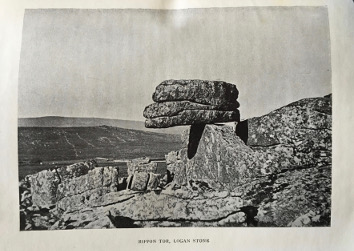
It is no longer a loganstone of course, and at the meeting it was said that a group of visitors tipped it over, to excite us no more. When exactly did this happen?
In the background of the picture you can see Hameldown, Pil Tor and the Newhouse Inn - fascinating.
This led on to thoughts of the Rugglestone loganstone. Is there a picture of that while still a loganstone? I can find a picture of it fallen but not before. When did it fall?
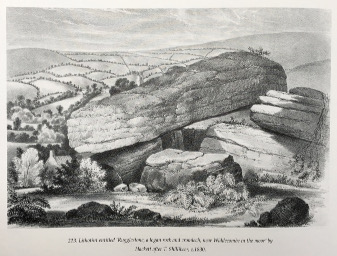
This picture of the Rugglestone loganstone is reproduced in Todd Gray's book 'Dartmoor Engraved' published by The Mint Press in 2001 (page 190). It was engraved by Hackett after the original work by T. Shillibeer and was originally published in 1830. The original is in the West Country Studies Library under reference SC3460. Note the church and the buildings on the left-hand-side. The stone has clearly fallen even by 1830.
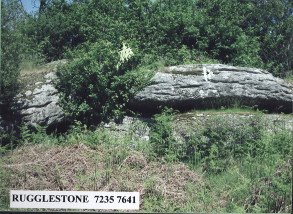
This photograph of the Rugglestone was taken by Roger Whale, as part of a series recording the Widecombe Town Manor boundary stones. It also gives the grid reference so you can visit it, although it is a bit tricky to get to. See also the Hendisstone in the Miscellaneous Topics One entries.
Widecombe Village Sign
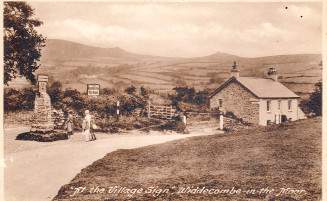
The current village sign was erected after the second world war to replace the previous one which had been damaged beyond repair when it was moved during the war.
In the picture it appears that the top of the sign is ceramic (perhaps tiles?) with a metal surround. Did these really get damaged beyond repair? One can imagine the granite plinth being re-used and perhaps the top did get damaged but has it disappeared entirely? Does anyone know if the tiles etc are still around somewhere?
The other thing that has occurred to me is when this original sign was first erected. I am not sure we have any records of that (but see below for the answer to this).
Our thanks to Roger Tebbutt who sent in a photo of his parents and family around the sign taken in 1938 and started this food for thought item.
The old village sign was unveiled in 1922. When it was removed during the second world war the top was apparently damaged beyond repair. The granite in the base was re-used as the base for the new sign.
North Hall (July 2017 Dig)
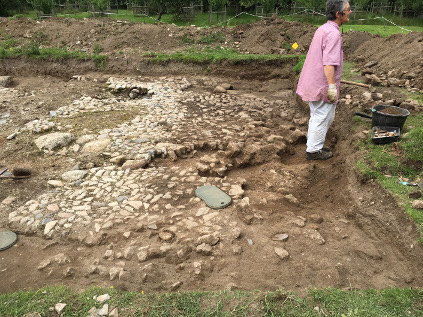
There has once again been a dig at the North Hall site. In 2017 it was a two-day affair to dig some test pits prior to a hopefully two-week dig the year after (which did happen). It was a very successful two days, well attended, and we found lots of pottery sherds that have now gone away to be identified.
They also uncovered more of the cobbled courtyard area and there is more still tantalisingly covered waiting for next year. See some more pictures below.
The dig was supported by the archaeologists at DNPA and the Moor Than Meets The Eye project.
Lizwell Pack-horse Bridge
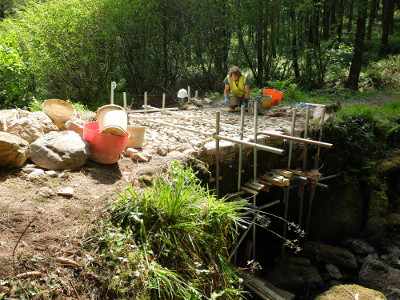
This bridge is being restored by Buckland Parish and Pat Watson has taken some photos of the restoration work. More to follow when work is complete.
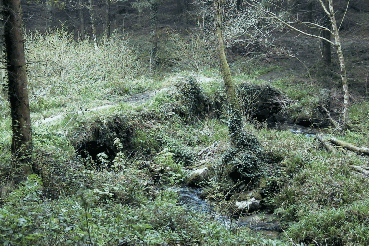
We also have a picture of this bridge, which crosses the East Webburn north of the point it meets the West Webburn, taken in 2000.
Great Elizabeth Mine
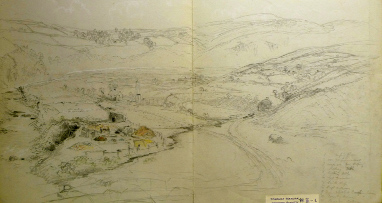
This copper mine operated just above Newbridge in the 1800s and this image, provided by Pat Watson and sourced from the Torquay Natural History Society, gives a good idea of what it must have been like around the Hannaford area of the parish. Close study reveals some well-known landmarks, such as Dr Blackall's Drive and the road up Newbridge Hill. You can see various remains of this mine today if you walk from the car park in the direction away from the main Ashburton to Princetown road.
New Stile at Northway Bridge
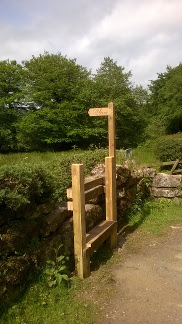
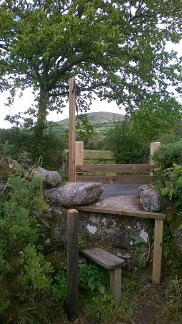
DNPA have erected a new stile at Northway Bridge. Thanks to David Ashman for supplying the photos.


